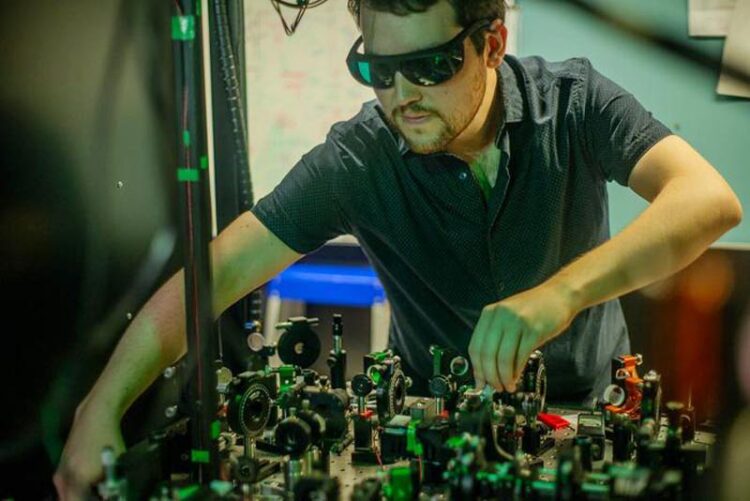Combatting disruptive ‘noise’ in quantum communication

PhD researcher Luis Villegas Aguilar conducting the experiment
Credit: Griffith University
In a significant milestone for quantum communication technology, an experiment has demonstrated how networks can be leveraged to combat disruptive ‘noise’ in quantum communications.
The international effort led by researchers from Griffith University’s Centre for Quantum Dynamics highlights the potential of quantum networks in revolutionising communication technologies on a quantum level.
Researchers Dr Nora Tischler and Dr Sergei Slussarenko, Program Managers at the ARC Centre of Excellence for Quantum Computation and Communication Technology (CQC2T) node at Griffith University, believe their findings were a first step towards large-scale quantum networks, which may fundamentally change how we communicate on a global scale.
The study delves into the intricate world of quantum entanglement—a phenomenon where particles maintain a connection regardless of the distance between them. Quantum entanglement, which has long been recognised as a cornerstone of quantum technology, has intrigued scientists due to its potential applications in hyper-sensitive sensors and ultra-private communication channels.
CQC2T PhD Researcher Luis Villegas-Aguilar, alongside the team at Griffith University, embarked on a journey to explore the relationship between quantum entanglement and nonlocality—mysterious correlations that Einstein famously referred to as “spooky action at a distance.”
The degradation of these quantum effects due to noise has posed a major challenge in realising their practical applications. The experiment conducted by the research team addressed this challenge head-on.
“In essence, our experiment demonstrates how networks can be utilised to overcome noise in quantum communications,” explains Villegas-Aguilar. “By simulating real-world conditions within a controlled environment, we aimed to enhance noise tolerance and ‘activate’ quantum nonlocality within a network structure.”
To realise this goal, they joined forces with researchers from the University of New South Wales, Sorbonne University, France, and the National Institute of Standards and Technology in the US. The team set up a three-station quantum network in their laboratories, mimicking configurations one might find in a future quantum internet.
“In our experiment, we sent the entangled particles to different stations inside the lab. We used entangled single photons, which are quantum particles of light,” Dr Tischler said.
“The three-station quantum network, simulating noisy conditions that one might encounter in a larger, field-deployed network. First, we started with only two entangled photons and proved they could not produce quantum nonlocality past a specific noise limit.”
Then, through meticulous design and implementation, the researchers observed a remarkable phenomenon: the previously lost quantum nonlocality could be recovered by adding an extra connectivity link.
“We observed that adding the third station to the network configuration allowed us to overcome the effects of noise and activate quantum nonlocality,” says Dr Emanuele Polino, a Postdoctoral Researcher involved with the experiment.
The team are confident that their results not only advanced our understanding of quantum phenomena, but also paved the way for the development of resilient and robust quantum technologies.
As the world continues to progress towards an era of quantum computing and communication, this research represents a significant milestone in harnessing the full potential of quantum mechanics.
The study ‘Nonlocality activation in a photonic quantum network’ has been published in Nature Communications.
Journal: Nature Communications
DOI: 10.1038/s41467-024-47354-w
Method of Research: Experimental study
Article Title: Nonlocality activation in a photonic quantum network
All latest news from the category: Information Technology
Here you can find a summary of innovations in the fields of information and data processing and up-to-date developments on IT equipment and hardware.
This area covers topics such as IT services, IT architectures, IT management and telecommunications.
Newest articles
Faster, more energy-efficient way to manufacture an industrially important chemical
Zirconium combined with silicon nitride enhances the conversion of propane — present in natural gas — needed to create in-demand plastic, polypropylene. Polypropylene is a common type of plastic found…

Energy planning in Ghana as a role model for the world
Improving the resilience of energy systems in the Global South. What criteria should we use to better plan for resilient energy systems? How do socio-economic, technical and climate change related…

Artificial blood vessels could improve heart bypass outcomes
Artificial blood vessels could improve heart bypass outcomes. 3D-printed blood vessels, which closely mimic the properties of human veins, could transform the treatment of cardiovascular diseases. Strong, flexible, gel-like tubes…





















